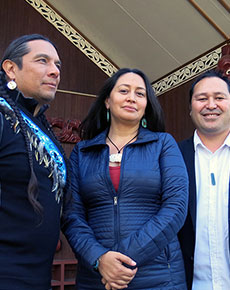Ka Haka: Empowering Māori and Indigenous performance

Ka Haka: Empowering Performance, New Zealand’s first Māori and Indigenous performance studies symposium was held on Ngā Wai o Horotiu Marae at Auckland University of Technology (AUT) on September 8-9.
Organiser, Dr Valance Smith, says Te Ara Poutama, the Faculty of Māori and Indigenous Development at AUT, created the event to provoke new ways of thinking about the relationship between performance and culture – to address complex issues regarding indigenous performance, because ‘those sensitive topics, are the topics that we need to discuss’.
For two days, more than 30 academics and artists contributed, through presentation and performance, to a conversation that explored power and performance in the development of Indigenous identity, culture and community.
What power does a kapa haka performer, like actor Cliff Curtis, carry with him from the stage to the screen? What happens when the power of haka is claimed by non-Māori; and who is entitled to claim that power? How does educating young people as entrepreneurial entertainers lead to their emancipation? What is the role of the reviewer in responding to Indigenous performance?
Eddie Madril, a member of the Pascua Yaqui tribe of Southern Arizona and Northern Sonora Mexico, has represented his Native American culture through various aspects – as a dancer, singer, teacher, playwright and filmmaker – for almost 30 years.
Madril and the equally accomplished Sara Moncada head the Sewam American Indian Dance company, which performs across the United States and internationally. Together, they attended Ka Haka as guests of AUT.
Sitting on Ngā Wai o Horotiu Marae more than 10,000 kms from their home in San Francisco – the setting is unfamiliar, but the conversation is very much the same.
“To see many nations within a nation going through the exact same things – I felt like I was listening to the voices of the American Indian people,” says Madril.
As inhabitants of a traditional creative space, ‘moving in and out of ritual and ceremony and performance’, that common language, explains Moncada, is born of ‘the power of representing your tribe, your people, your nations and your lands’.
“Sometimes, when you stop to think of the enormity of that, it can be quite overwhelming. So, to come together in a forum like this, to explore that complexity – it feels like taking a collective deep breath,” she says.
For Ka Haka, Dr Smith and Madril created a unique trans-Indigenous performance – a waiata composed by the former, provided the starting point for a traditional hoop dance, choreographed and performed by the latter.
The collaboration, says Madril, was a way to show two people from two different nations – Māori and American Indian – ‘storytelling through music and dance,’ and bringing together two natural languages.
“Sometimes, people put their energy into what they want the audience to see or feel – or to fill seats. But, this wasn’t about that. It was to bring two worlds together,” he says.
Maree Sheehan, a lecturer at AUT and an accomplished singer-songwriter and producer, has been involved in the New Zealand music industry for more than 20 years.
She facilitated a conversation, on Mana Wahine: Māori Women in Music, with Moana Maniapoto and Hinewihi Mohi – pioneers of popular and political music during the 1990s.
At that time, Māori were applying pressure on the New Zealand Government to allocate more resources to Māori broadcasting. By 1993, New Zealand on Air was funding 22 Māori radio stations, as well as the recording of music and music videos.
Both artists were writing modern waiata in te reo Māori or bilingually as a way of reclaiming their language and expressing their identity as Mana Wahine. They wanted to put Māori ‘out there, in a contemporary way – not an anthropological way’.
One of the tensions at the time, says Maniapoto, especially when performing overseas, was the feeling that ‘sometimes you’re not Māori enough’. “They wanted to see you chant and do the haka.”
She drew inspiration from what was going on around her. Songs like Treaty were in direct response to the fiscal envelope – a plan to impose a financial cap on all future treaty settlements.
Maniapoto’s stance has since softened. While still a provocative songwriter, she is more focused on trying to ‘mobilise togetherness’. “Now, I’m using my music to reach out to everyone.”
Unlike other symposiums, Ka Haka wasn’t confined to the formality of research presentations. Papers were published in advance on Te Kaharoa.com, lending the event greater elasticity.
Academics and artists in Indigenous performance seldom have the opportunity to express themselves in a public forum like this – where they feel comfortable, says Dr Smith. “But, I believe that Ka Haka provided that platform.”
Moncada agrees. “The ability to approach subjects that are sensitive and require critical inquiry – with awareness of the depth and seriousness of these topics, but also with good humour – is part of how our thinking becomes holistic.”
To close Ka Haka, Professor Pare Keiha, Pro-Vice Chancellor of Te Ara Poutama and Māori Advancement at AUT, applauded the contribution of Māori and Indigenous artists.
“Through defiance and through sheer will – but, more importantly, through the sheer love of performance, they have done much to transform the appreciation of culture, amongst ourselves and others.”
Te Ara Poutama at AUT is more than a learning space, it’s a community. It lives out of the idea of Whakapakari – to discover, evolve and grow.
Picture caption:
Eddie Madril, Sara Moncada and Dr Valance Smith